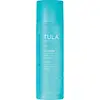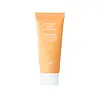What's inside
What's inside
 Key Ingredients
Key Ingredients

 Benefits
Benefits

 Concerns
Concerns

No concerns
 Ingredients Side-by-side
Ingredients Side-by-side

Water
Skin ConditioningGlycolic Acid
BufferingButylene Glycol
HumectantGlycerin
HumectantSodium Hydroxide
BufferingPolyacrylate Crosspolymer-6
Emulsion StabilisingLactococcus Ferment Lysate
Skin ConditioningLactobacillus/Punica Granatum Fruit Ferment Extract
Skin ConditioningLactobacillus/Papaya Fruit Ferment Extract
AbrasiveLactobacillus
Skin ConditioningCichorium Intybus Root Extract
MaskingSalix Nigra Bark Extract
Skin ProtectingGluconolactone
Skin ConditioningMelia Azadirachta Flower Extract
Skin ConditioningCorallina Officinalis Extract
Skin ConditioningMelia Azadirachta Leaf Extract
Skin ConditioningLeuconostoc/Radish Root Ferment Filtrate
AntimicrobialCurcuma Longa Root Extract
MaskingCoccinia Indica Fruit Extract
Skin ConditioningVinegar
Rubus Fruticosus Fruit Extract
AstringentAnanas Sativus Fruit Extract
Skin ConditioningLactic Acid
BufferingOcimum Basilicum Flower/Leaf Extract
TonicOcimum Sanctum Leaf Extract
Skin ConditioningAloe Barbadensis Flower Extract
EmollientSolanum Melongena Fruit Extract
Skin ConditioningSodium Benzoate
MaskingSodium Chloride
MaskingPotassium Sorbate
PreservativeCaramel
Cosmetic ColorantCaprylyl Glycol
Emollient1,2-Hexanediol
Skin ConditioningWater, Glycolic Acid, Butylene Glycol, Glycerin, Sodium Hydroxide, Polyacrylate Crosspolymer-6, Lactococcus Ferment Lysate, Lactobacillus/Punica Granatum Fruit Ferment Extract, Lactobacillus/Papaya Fruit Ferment Extract, Lactobacillus, Cichorium Intybus Root Extract, Salix Nigra Bark Extract, Gluconolactone, Melia Azadirachta Flower Extract, Corallina Officinalis Extract, Melia Azadirachta Leaf Extract, Leuconostoc/Radish Root Ferment Filtrate, Curcuma Longa Root Extract, Coccinia Indica Fruit Extract, Vinegar, Rubus Fruticosus Fruit Extract, Ananas Sativus Fruit Extract, Lactic Acid, Ocimum Basilicum Flower/Leaf Extract, Ocimum Sanctum Leaf Extract, Aloe Barbadensis Flower Extract, Solanum Melongena Fruit Extract, Sodium Benzoate, Sodium Chloride, Potassium Sorbate, Caramel, Caprylyl Glycol, 1,2-Hexanediol
Water
Skin ConditioningGlucose
HumectantGlycerin
HumectantDiglycerin
HumectantMethyl Gluceth-20
HumectantSucrose
Humectant1,2-Hexanediol
Skin ConditioningGluconolactone
Skin ConditioningBetaine
HumectantSqualane
EmollientCarbomer
Emulsion StabilisingTromethamine
BufferingXylitol
HumectantButylene Glycol
HumectantCaprylyl Glycol
EmollientHydroxyacetophenone
AntioxidantPentylene Glycol
Skin ConditioningDipotassium Glycyrrhizate
HumectantDisodium EDTA
Hydroxyethylcellulose
Emulsion StabilisingPanthenol
Skin ConditioningAllantoin
Skin ConditioningEthylhexylglycerin
Skin ConditioningSodium Hyaluronate
HumectantWater, Glucose, Glycerin, Diglycerin, Methyl Gluceth-20, Sucrose, 1,2-Hexanediol, Gluconolactone, Betaine, Squalane, Carbomer, Tromethamine, Xylitol, Butylene Glycol, Caprylyl Glycol, Hydroxyacetophenone, Pentylene Glycol, Dipotassium Glycyrrhizate, Disodium EDTA, Hydroxyethylcellulose, Panthenol, Allantoin, Ethylhexylglycerin, Sodium Hyaluronate
 Reviews
Reviews

Ingredients Explained
These ingredients are found in both products.
Ingredients higher up in an ingredient list are typically present in a larger amount.
1,2-Hexanediol is a synthetic liquid and another multi-functional powerhouse.
It is a:
- Humectant, drawing moisture into the skin
- Emollient, helping to soften skin
- Solvent, dispersing and stabilizing formulas
- Preservative booster, enhancing the antimicrobial activity of other preservatives
Butylene Glycol (or BG) is used within cosmetic products for a few different reasons:
Overall, Butylene Glycol is a safe and well-rounded ingredient that works well with other ingredients.
Though this ingredient works well with most skin types, some people with sensitive skin may experience a reaction such as allergic rashes, closed comedones, or itchiness.
Learn more about Butylene GlycolCaprylyl Glycol is a humectant and emollient, meaning it attracts and preserves moisture.
It is a common ingredient in many products, especially those designed to hydrate skin. The primary benefits are retaining moisture, skin softening, and promoting a healthy skin barrier.
Though Caprylyl Glycol is an alcohol derived from fatty acids, it is not the kind that can dry out skin.
This ingredient is also used as a preservative to extend the life of products. It has slight antimicrobial properties.
Learn more about Caprylyl GlycolGluconolactone is a PHA. PHAs are a great gentle alternative to traditional AHAs.
When applied, Gluconolactone has the same affect on skin as AHAs such as lactic acid. It helps dissolve the dead skin cells in the top layer of your skin. This improves texture and brightens the skin.
PHAs are more gentle than AHAs due to their larger structure. They do not penetrate as deeply as AHAs and take a longer time to dissolve dead cells. Studies show PHAs do not cause as much irritation.
Gluconolactone has some interesting properties:
In a 2004 study, Gluconolactone was found to prevent UV damage in mouse skin cells and has not been found to increase sun sensitivity. However, we still recommend wearing SPF daily.
This ingredient is is an created by reacting gluconic acid with an alcohol.
Learn more about GluconolactoneGlycerin is already naturally found in your skin. It helps moisturize and protect your skin.
A study from 2016 found glycerin to be more effective as a humectant than AHAs and hyaluronic acid.
As a humectant, it helps the skin stay hydrated by pulling moisture to your skin. The low molecular weight of glycerin allows it to pull moisture into the deeper layers of your skin.
Hydrated skin improves your skin barrier; Your skin barrier helps protect against irritants and bacteria.
Glycerin has also been found to have antimicrobial and antiviral properties. Due to these properties, glycerin is often used in wound and burn treatments.
In cosmetics, glycerin is usually derived from plants such as soybean or palm. However, it can also be sourced from animals, such as tallow or animal fat.
This ingredient is organic, colorless, odorless, and non-toxic.
Glycerin is the name for this ingredient in American English. British English uses Glycerol/Glycerine.
Learn more about GlycerinWater. It's the most common cosmetic ingredient of all. You'll usually see it at the top of ingredient lists, meaning that it makes up the largest part of the product.
So why is it so popular? Water most often acts as a solvent - this means that it helps dissolve other ingredients into the formulation.
You'll also recognize water as that liquid we all need to stay alive. If you see this, drink a glass of water. Stay hydrated!
Learn more about Water